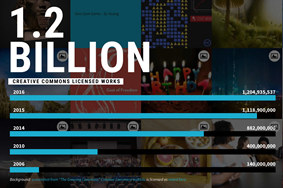The State of the Commons

The much anticipated first day of the Creative Commons summit finally arrived, with the CEO proud to announce not just a new report but a new emphasis and focus for the organisation.
Today, Friday 28th April, marks not only the first day of the Creative Commons Global Summit 2017 in Toronto but also the launch of the State of the Commons report. Introduced at the opening session by Creative Commons’ Jane Daily, the report focuses on measuring collaboration. Previous Commons reports have largely focused on quantitative data analysis, such as enumerating CC licensed works and calculating the distribution of different licenses. Although such data are still included, the emphasis now is on social impact - the value of the Commons. From today’s talks it has become clear that an organisation that started out as a provider of licenses for rights management has truly become a global movement promoting knowledge sharing aiming “to build a more equitable, accessible, and innovative world”. The global reach of the Commons was also made clear from this year’s report’s availability in 13 different languages, making it the most widely accessible report to date - an impressive achievement.
 This year’s report shows that although growth from 2015 to 2016 was lower than in previous years it is still significant and there are now over 1.2 billion Creative Commons licensed works. To put this into perspective, for every 6 people on the planet there is at least one CC licensed work. The CC are also proud that 65% of these works are shared under “Free Culture” licenses, so that these works can be easily used and distributed.
This year’s report shows that although growth from 2015 to 2016 was lower than in previous years it is still significant and there are now over 1.2 billion Creative Commons licensed works. To put this into perspective, for every 6 people on the planet there is at least one CC licensed work. The CC are also proud that 65% of these works are shared under “Free Culture” licenses, so that these works can be easily used and distributed.
The Creative Commons has now set its sights on “moving beyond licenses to enhance collaboration and sharing” as one of its 3 main goals of the Global Summit, and therefore seeks to establish the extent of collaboration already in place. This is a relatively hard and messy concept to measure and interpret, Jane explained. The CC has chosen a unique way to show the impacts of its collaboration, through the use of 12 stories from around the world. These stories illustrate the impacts that CC projects have had on people and communities.
The stories are all strong examples of how CC has achieved global impact, but one that I found particularly fascinating was the story of an open data portal in El Salvador. The portal provides access to data created by citizens, licensed under the CC, and has published more than 500 sources of data. These datasets relate to many different fields from education to journalism to business, and can improve efficiency by reducing costs (meaning, for example, that less time needs to be spent on finding reliable data).

The fact that CC has put the time and effort into collecting, analysing and reporting the data shows this is a very reflective organisation which uses understandings of previous performance in order to establish a model for the future. The world is an ever-changing place and the CC will face many challenges in the future; it is an organisation that is aware of these potential challenges and seeks to deal with these challenges through collaboration. In terms of looking to the future, the CC wants to find better ways to understand and report the impact of its collaboration and is hoping the summit this weekend will bring new ideas.
Amy Lees is studying a BSc in Economics. Her interests lie in the ‘Future of the Commons’. She is interested in how the Creative Commons can fuel innovation and new ideas which in turn, can fuel growth. With the idea that the Creative Commons reduces asymmetric information Amy will be attending an array of talks which focus on business models which are based on CC.

